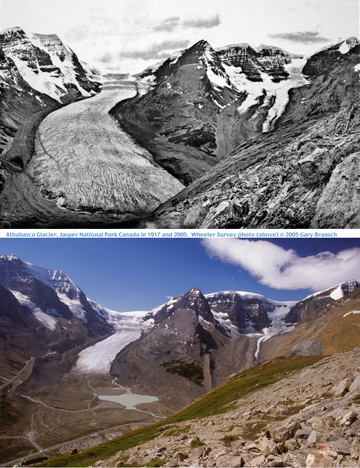 The first photographs made for World View of Global Warming, ten years ago, were of glaciers in Antarctica and Peru. This page shows a selection of the locations where we have documented glacier and ice cap retreat -- a small set of images illustrating the overwhelming evidence from hundreds of glaciers and ice caps on every continent that global warming is severely affecting the water and glacial cycles of the planet. This is a profound change that unlike natural cycles like the Little Ice Age of the 16th and 17th centuries is proceeding very rapidly and appears tied to no natural cycles. The best correlation for this change to all but a handful of the 160,000 land glaciers and parts of the great ice caps is to rising atmospheric temperatures tied to increasing amounts of greenhouse gases.
The first photographs made for World View of Global Warming, ten years ago, were of glaciers in Antarctica and Peru. This page shows a selection of the locations where we have documented glacier and ice cap retreat -- a small set of images illustrating the overwhelming evidence from hundreds of glaciers and ice caps on every continent that global warming is severely affecting the water and glacial cycles of the planet. This is a profound change that unlike natural cycles like the Little Ice Age of the 16th and 17th centuries is proceeding very rapidly and appears tied to no natural cycles. The best correlation for this change to all but a handful of the 160,000 land glaciers and parts of the great ice caps is to rising atmospheric temperatures tied to increasing amounts of greenhouse gases.
The largest implication of this loss of glaciers is not the change in scenery, but the fact that the seasonal meltwater from glaciers, especially in Asia and South America, is the life support for billions of people. Large cities like Lima get much of their water from glaciers. In other parts of the world, glacier water keeps streams cool and full for salmon and other important wildlife. And as more and more water reaches the ocean, it is increasing sea level at a faster rate --- which threatens every coastal city and shoreline. New scientific projections show at least a three foot (one meter) rise in ocean levels by the end of this century, part of which is also due to the expansion of warming sea water. This will inundate rice fields and estuaries that feed billions, and push into the heart of the worlds largest cities --- and make each storm a threat of more devastating waves and surges.
1919 image of Athbasca Glacier, Jasper National Park, Canada, courtesy National Archives of Canada, from the Wheeler Survery; 2005 image © Gary Braasch



